
Dairy Nutrition Guidelines
Dairy Foods provide:
- 7 of the 14 key nutrients for early brain development
- More bone-building nutrients than any other food group
- Important nutrients for immune health, growth and development
-
Dairy Throughout the Lifespan, Essential Nutrients and Dairy Food Recommendations
Click the plus symbol (+) next to each tip to learn more
The Benefits of Dairy Foods Throughout the Lifespan
Infants 6-11 Months:
Building the foundation for healty eating.
At about 6 months, infants should be introduced to nutrient-rich, developmentally appropriate foods to complement human milk or infant formula feedings to ensure adequate nutrition and encourage acceptance of a wide variety of nutritious foods. Cheese and yogurt offer a range of diverse tastes and textures, which can help support development of future healthy eating habits.

Toddlers 12-23 Months:
Supporting growth and development.
After their first birthday, as babies transition from human milk or iron-fortified infant formula, whole milk and other dairy foods emerge as critically important sources of essential nutrients to support growth and development.
Preschoolers 2-5 Years:
Delivering high-quality nutrition.
Leading health experts agree water and plain milk are the only recommended beverages for children 1 to 5 years of age. Plant based alternatives are not recommended due to their wide variability in nutrient content, limited evidence of bioavailability and impact on diet quality and health outcomes.

Pregnant and Breastfeeding Women:
Supporting baby’s brain development.
Pregnant and breastfeeding women need higher amounts of some nutrients including vitamin B12, iodine and choline. As excellent sources of vitamin B12, dairy foods help support a healthy pregnancy and may help prevent vitamin B12 deficiency in infants which can lead to permanent neurological damage. As good sources of iodine, milk and yogurt may help protect against neurocognitive defects and lower childhood IQ linked to prenatal iodine deficiency. Plus, the choline† found in dairy foods can help replenish maternal stores and support the growth and development of the baby’s brain and spinal cord.
†One serving of milk provides 8% of the Daily Value for choline
To learn more about the other life stages tap here.
The Importance of Iodine in Prenatal Brain Development
Why is Iodine Important?
Iodine is an essential micronutrient needed to make thyroid hormones, which are important for metabolism, as well as proper brain and bone development during pregnancy and infancy. Iodine needs increase by more than 50% during pregnancy and many women of childbearing age are iodine deficient before they even become pregnant. In particular, women who do not regularly consume dairy foods, eggs, seafood or use iodized table salt, may not consume enough to meet increased needs during pregnancy and lactation. This is concerning because prenatal iodine deficiency may lead to irreversible neurocognitive defects and lower childhood IQ.
Iodine deficiency is the
most preventable cause of
intellectual disability.
What Foods Provide Iodine?
Slide the table to see all catagories
**Cracker sized slice of cheese

Easy Iodine Ideas
Milk It: Milk provides a powerful package of iodine, vitamin B12 and choline*, all of which support baby’s brain development, as well as other important nutrients like protein, calcium and vitamin D. Lactose intolerant? Most people with lactose intolerance can tolerate varied amounts of lactose. Also, lactose-free milk is real milk, just without the lactose.
Get Cultured with Yogurt: Made from the goodness of milk, yogurt is a fermented food that also provides iodine, vitamin B12, protein and calcium. Yogurt’s live and active cultures help to digest lactose, plus Greek and Icelandic yogurts have even less lactose because of the straining process.
Say Cheese: Cheeses are also easily accessible sources of iodine, as well as protein, vitamin B12 and calcium. Natural cheeses, such as Cheddar and Swiss, contain minimal amounts of lactose. Avoid unpasteurized cheeses, like Brie and Feta, during pregnancy. Visit USDairy.com for research, resources and recipes.
Put an Egg on It: Eggs provide 8 essential nutrients including iodine, choline, vitamin B12 and protein. Visit Egg Nutrition Center for additional information.
Go Fish: Fish and seafood can be good sources of iodine, as well as protein, omega-3 fatty acids and vitamin B12. Pregnant and breastfeeding women should choose options lower in methylmercury, like cod and salmon. Learn more at FDA’s Advice About Eating Fish.
(*8% DV for Choline)
For more information on Iodine ask your dietitian, doctor, or WIC practitioner or specialist.
National Institutes of Health. Office of Dietary Supplements. Iodine Factsheet for Consumers. https://ods.od.nih.gov/factsheets/Iodine Consumer. Accessed February 23, 2021.
Dietary Guidelines Advisory Committee. 2020. Scientific Report of the 2020 Dietary Guidelines Advisory Committee: Advisory Report to the Secretary of Agriculture and the Secretary of Health and Human Services. U.S. Department of Agriculture, Agricultural Research Service, Washington, DC. https:// www.dietaryguidelines.gov/2020-advisory-committee-report.
Panth P, Guerin G, DiMarco N. A Review of Iodine Status of Women of Reproductive Age in the USA. Biological Trace Element Research (2019) 188:208 220 https://doi.org/10.1007/s12011-018-1606-5
U.S. Department of Agriculture and U.S. Department of Health and Human Services. Dietary Guidelines for Americans, 2020-2025. 9th Edition. December 2020. https://www.dietaryguidelines.gov/sites/default/files/2020-12/Dietary_Guidelines_for_Americans_2020-2025.pdf Accessed February 23, 2021
Centers for Disease Control. Second Nutrition Report Factsheet. Iodine Levels in Young Women Boarder on Insufficiency. https://www.cdc.gov/ nutritionreport/pdf/Second-Nutrition-Report-Iodine-Factsheet.pdf
IRI Multi Outlet + Conv 2020, YTD ending 10-4-20. Based on U.S. average price of unflavored, branded and private label milk, 1 gal.
USDA, FDA and ODS-NIH Database for the Iodine Content of Common Foods per serving, Release 2 (January 2022). https://www.ars.usda.gov/ ARSUSERFILES/80400535/DATA/IODINE/IODINE%20DATABASE_R\ LEASE_2_DOCUMENTATION.PDF
Essential Nutrients in Milk and Dairy Foods
Milk and Dairy Foods Can Contribute Essential Nutrients to the Daily Diets of Americans
One serving of milk contains many of the essential nutrients your body needs, including:
Helps build and maintain strong bones and teeth.
Helps build and repair tissue. Helps maintain a healthy immune system.
Helps build and maintain strong bones and teeth. Helps maintain a healthy immune system.
Helps build and maintain strong bones and teeth, supports tissue growth.
Helps keep skin and eyes healthy; helps promote growth. Helps maintain a healthy immune system.
Helps your body use carbohydrates, fats and protein for fuel.
Helps maintain healthy immune, blood and nervous system function. Supports normal energy metabolism. Necessary for brain development during pregnancy and infancy; linked to cognitive function in childhood.
Helps your body use carbohydrates, fats and protein for fuel.
Used in energy metabolism in the body.
Helps maintain a healthy immune system and healthy skin, and helps support normal growth and development.
Helps maintain a healthy immune system, helps regulate metabolism and helps protect healthy cells from damage.
Necessary for proper bone and brain development during pregnancy and infancy; linked to cognitive function in childhood.
Helps maintain a healthy blood pressure and supports heart health. Helps regulate body fluid balance and helps maintain normal muscle function.
USDA Food Data Central onlineathttps://fdc.nal.udsa.gov/.Mean values calculated from database entries across all fat levels of plain vitamin D fortified fluid milk in Legacy, Foundation, (FNDDS) data sources. 9
All About Lactose Intolerance
Click the plus symbol (+) next to each tip to learn more
Lactose Intolerance 101
How to Enjoy Dairy Foods with Confidence
Lactose is a sugar that is naturally found in dairy foods and breast milk. Lactose intolerance in children is rare. As you age, everyone tolerates lactose differently.
The good news is there are a variety of lactose-free and lower-lactose choices that deliver on taste and nutrition.
Amount of Lactose per Serving From Lowest to Highest
Lactose-free Dairy Milk 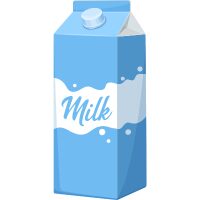 0g
0g
1 CUP (8 OZ) SERVING
Lactose-free dairy milk is real milk, just without lactose.
Butter 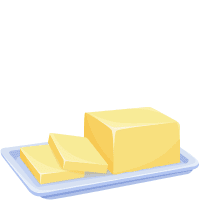 less than 1g
less than 1g
1 TBSP SERVING
Butter is made by separating milk from butter fat, so there are only trace amounts of lactose, if any.
Natural Cheeses 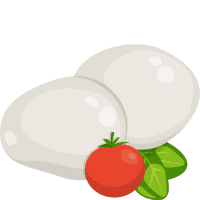 less than 1g
less than 1g
1.5 OZ SERVING
Due to the steps in cheese making and natural aging, natural cheese contains minimal amounts of lactose. Natural cheeses like Cheddar and mozzarella have less than 1 gram of lactose.
American Cheese  1.2g
1.2g
1 SLICE SERVING
American cheese is made from natural cheese, which contains minimal lactose.
Ricotta Cheese  1.9g
1.9g
1/4 CUP SERVING
This soft, natural cheese contains minimal amounts of lactose.
Cottage Cheese  3.2g
3.2g
1/2 CUP SERVING
Due to the steps in cheese making and curd separation, cottage cheese has a fraction of the lactose in milk. Lactose free options are also available.
Ice Cream  3.9g
3.9g
2/3 CUP SERVING
There are lactose-free dairy milk ice creams available.
Greek Yogurt 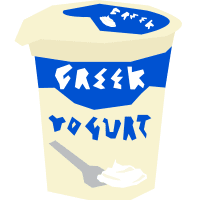 4.2g
4.2g
3/4 CUP SERVING
There is less lactose in Greek yogurt because the straining process removes some of the lactose.
Yogurt 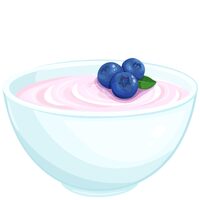 5.7g
5.7g
3/4 CUP SERVING
The live cultures in yogurt help digest some of the lactose.
Kefir 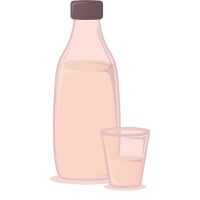 8.5g
8.5g
1 CUP SERVING
The live cultures in fermented milk products help digest some of the lactose.
Buttermilk 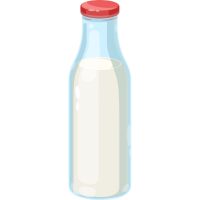 9g
9g
1 CUP (8 OZ) SERVING
Due to the steps in making buttermilk and its acidity, it naturally contains less lactose than regular milk.
Dairy Milk  12.6g
12.6g
1 CUP (8 OZ) SERVING
Try small amounts of dairy milk in smoothies, on cereal or with meals. Having milk with solid foods helps slow digestion, which can mean it’s better tolerated.
Make Every Bite and Sip Count
Click the plus symbol (+) next to each tip to learn more
Dairy Alternatives are Different Than Real Dairy Milk
What’s in Your Glass?
Choices are great, but they can be overwhelming.
This at-a-glance chart can help you understand what’s in your glass.
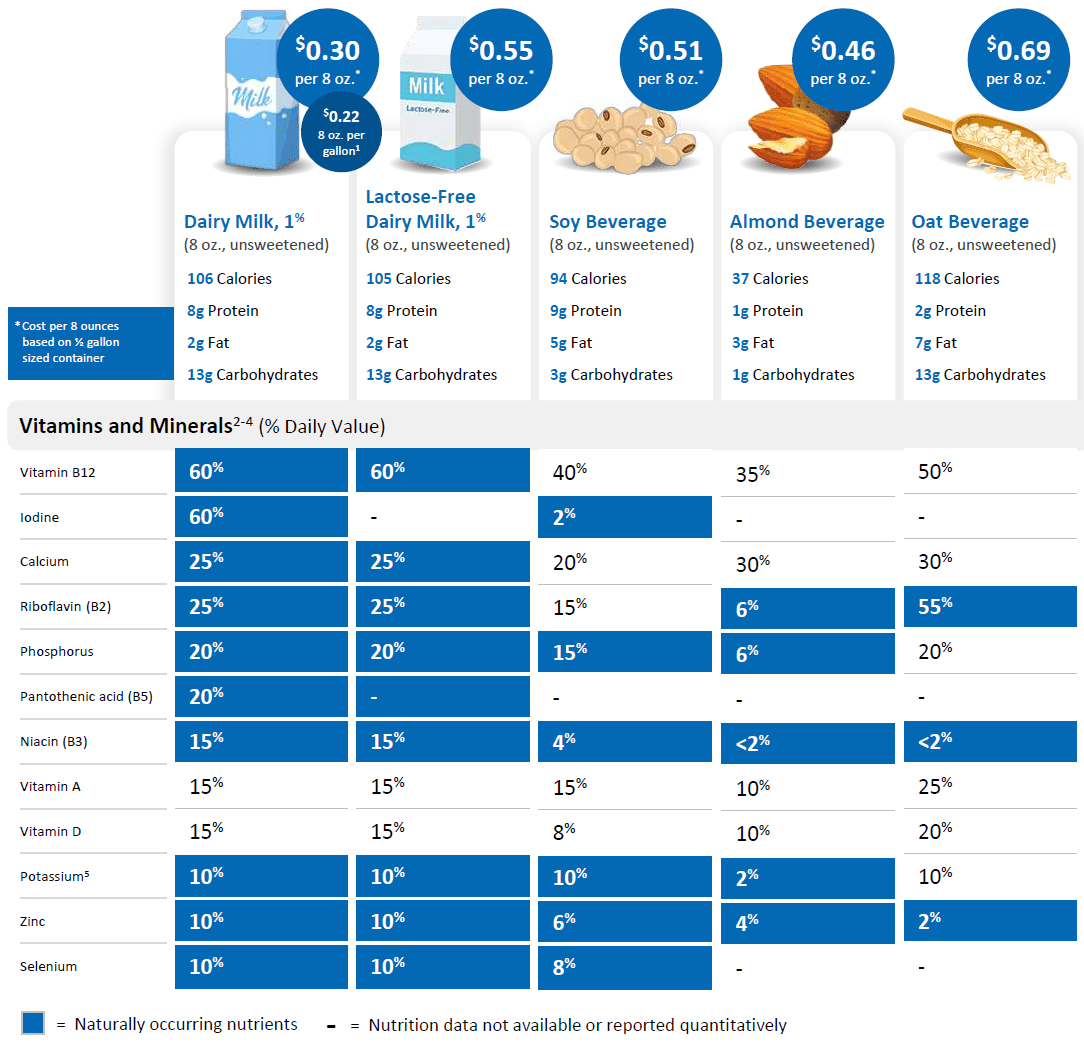
(Dairy milk, unflavored (1%); Dairy Milk, Lactose-Free, unflavored (1%), unflavored almond, soy and oat beverages.)
1. IRI Total US -Multi Outlet + Conv 2022 YTD ending 5-22, based on U.S. average price of unflavored, private label milk, 1 gallon.
2. USDA, Agricultural Research Service. FoodData Central, 2019. https://fdc.nal.usda.gov/. Foundation Foods. FDC IDs: 746772, 2340766, 1999630, 1999631, 2257046. Accessed July 2023.
3. USDA, Agricultural Research Service. USDA, FDA and ODS-NIH Database for the Iodine Content of Common Foods Release 3.0 (2023).
4. Naturally occurring nutrients based on publicly available product ingredient lists. Accessed July 2023.
5. FDA’s Daily Value (DV) for potassium of 4700 mg is based on a 2005 DRI recommendation. In 2019, NASEM updated the DRI to 3400 mg.
These values are based on the 2019 DRI of 3400 mg.
Dairy Food Recommendations
Daily Dairy Food Recommendations
*No longer receiving human milk or infant formula
Below are the recommended dairy servings for all ages and information on what counts as a serving of dairy.
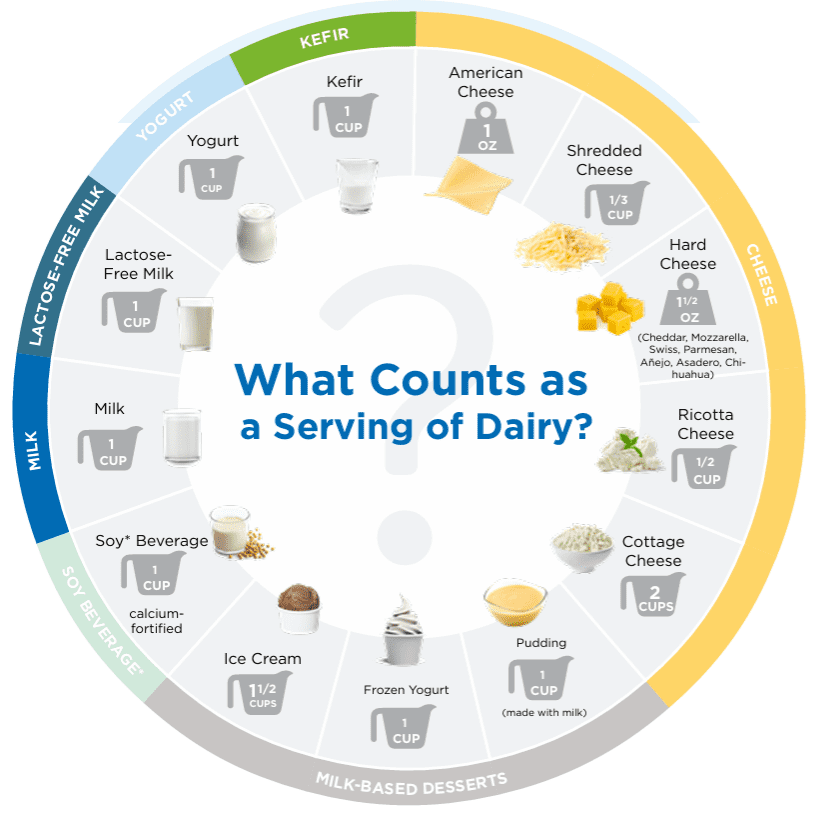
Dairy Education Videos
Click the plus symbol (+) to learn more
Pointers to Inspire Picky Eaters: Nurturing Food Explorers
What Are the Benefits of Dairy Foods for Pregnant Moms and Babies?
What Milk Should I Choose for My Toddler?
An Easy Recipe for Growing Brains, Bones, and Bodies
When Can My Baby Have Milk, Yogurt, and Cheese?
Featured Dairy Recipes
Click the plus symbol (+) to learn more



